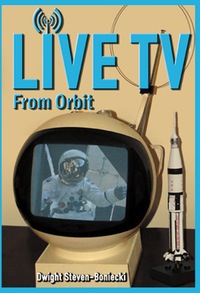Review: Live TV From Orbitby Jeff Foust
|
| Television got a higher profile on Apollo-Soyuz, given the geopolitical importance attached to the mission, but still posed difficulties fitting it into mission planning. |
In Live TV From Orbit, Dwight Steven-Boniecki examines the use of live television four decades ago. A sequel to his earlier Live TV From the Moon (see “Review: Live TV From the Moon”, The Space Review, June 21, 2010) that examined how NASA provided live television during the Apollo lunar missions, this book examines the use of television during the Skylab and Apollo-Soyuz missions, as well as the beginning of the Space Shuttle program. Those missions built upon the TV technology used for the Apollo landings, but with some incremental improvements, including the use of video recorders for the first time on Skylab to record video for later transmission back to Earth. Engineers also developed a telescoping boom with a camera on the end to be used during spacewalks outside Skylab; that boom, though, was never used because repairs to the station after it suffered damage during launch took away use of an access port that camera boom was to use.
The use of live television from space presented more than technical challenges as well. Tight budgets in the post-Apollo era at NASA put pressures on the development of television camera for use on Apollo-Soyuz and Skylab, and there were conflicts on the importance of television versus the program of experiments and other work the Skylab astronauts were tasked with doing. Television got a higher profile on Apollo-Soyuz, given the geopolitical importance attached to the mission, but still posed difficulties fitting it into mission planning. Cooperation with the Soviets also added complications, but also a little humor: American engineers examining a Russian TV camera noticed its design was very similar to the cameras built by Westinghouse, including components that Westinghouse had developed but eventually rejected for use on Apollo. When asked where the Russians got that component, they said it came from East Germany. “I decided I wasn’t going to explore that any further,” recalled Stan Lebar of Westinghouse.
Steven-Boniecki dives into the details of the development and use of television cameras on these missions, from diagrams of camera designs to a day-by-day recounting of their use during the missions. Unfortunately, the stills of some of those TV transmissions don’t come out well in the book: they’re printed in black and white, and often appear dark with little contrast, making it often hard to figure out what they’re supposed to be. (There are also a few typos and other errors in the book, including a series of diagrams labeled “TV Camera Locations on Apollo” that are instead diagrams of Soyuz spacecraft.) However, the book comes with a DVD that includes some video samples from the Skylab and Apollo-Soyuz missions; these much better show the capabilities live video offered at the time. The DVD also includes some source materials, such as manuals and planning documents, related to video use on those missions.
Live TV From Orbit is primarily for people with a deep interest in space and/or television history, given the level of detail it goes into what is a niche topic. It serves as a reminder of how far live television from space has come in the last four decades, progress that seems in many respects much faster than we have seen in spaceflight itself.
